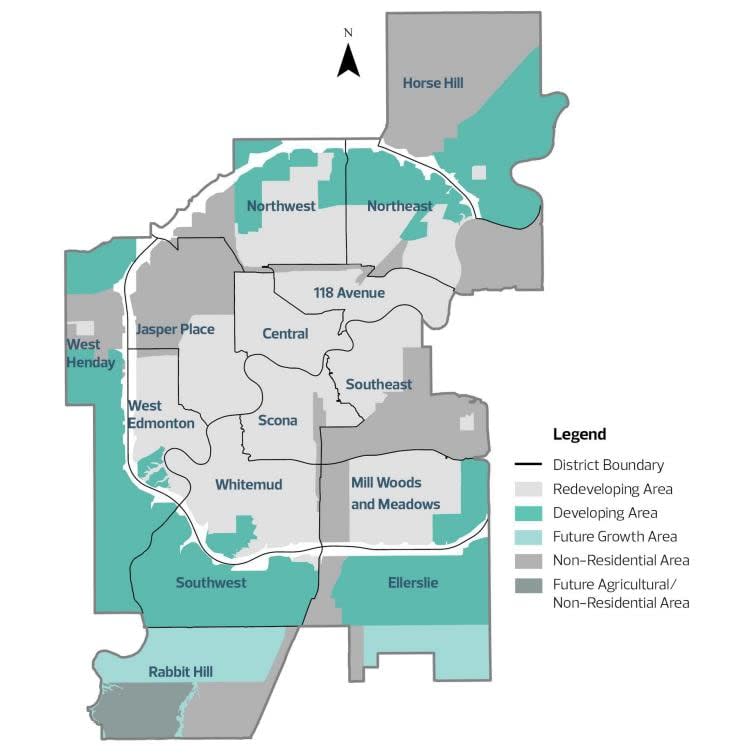Edmonton's plan to stop sprawl faces pushback from developers over housing affordability
Developers are pushing back against a city recommendation that would halt any planning and development on the outskirts of Edmonton to limit sprawl.
An urban planning committee Tuesday heard mixed feedback about the city's substantial completion approach, which prioritizes finishing infrastructure and amenities development before focusing on new areas.
Administration suggests halting any planning in annexed lands from Beaumont and Leduc, until 2029.
Adil Kodian, executive vice-president of Rohit Homes, warned that this strategy could affect housing affordability.
"By creating artificial curbs to bringing on new supply of housing, we end up creating a situation where not enough houses are being produced for the population growth that is coming," he told CBC's Edmonton AM Wednesday.
"We're already in the middle of a housing crisis and it does not look like the growth in population in Edmonton is going to stem anytime soon."
Edmonton metro's population reached 1.56 million in 2023.

Out of the city's 295 residential neighborhoods, 91 are considered developing areas, such as Ellerslie, west Henday, far northeast and southwest, that still need infrastructure development and amenities.
City administration wants to focus on the developing areas before moving on to lands annexed in 2019.
Kalen Anderson, CEO of Building Industry and Land Development Edmonton Metro, said the whole reason the city annexed the land in the first place was to accommodate a growing population and for development.
"We already knew we were running out of land to accommodate dense and diverse neighbourhoods," Anderson said.
Developers like Brad Armstrong, vice-president of community development for Qualico Communities, said planning and development takes multiple years and halting planning causes them to lose years of work needed to begin building homes.
"This is a big concern because of the length of time that it takes to assemble the land and then to go through the entire planning process," he said.
Climate, community considerations
Supporters of the city's approach believe it will attract young professionals and help meet the city's climate goals.
Dolly Cepeda Montufar emphasized the desire of young people like herself, for community-centric developments over single-family homes.
"If I'm walking for half an hour and all I see is houses, I don't want to live there," she said.
However, she said her immigrant parents chose Terwillegar in southwest Edmonton in 2009 for affordability — despite not having developed amenities or a strong sense of community.
Jacob Komar, co-chair of the city's Energy Transition and Climate Resilience Committee, stressed the importance of substantial completion in the entire city to meet the city's climate goals as urban areas contribute significantly to greenhouse gas emissions.
LISTEN | Developer concerned about city's proposal to halt planning of annexed lands:
He said urban sprawl increases car dependency and associated pollution, more land consumption and destruction of natural carbon sinks.
"Building efficient, dense urban developments is the best levers we have for reducing GHG emissions," he said.
As for Kodian, he said limiting development could increase commute times as people might choose to live outside the city.
"Aren't we just incentivizing the customer to drive another 10 minutes and go live in Beaumont?" he asked.
Coun. Tim Cartmell of ward Pihêsiwin, which includes the annexed lands, does not support the motion.
"I completely agree that we want to maximize the utility of the infrastructure we already have … but we absolutely need to plan," he said.
"We are seeing now that the pace of growth is far faster than we anticipated a few years ago. I see no problem at all with planning ahead."
The cost of sprawl
In response to concerns about affordability, Karen Burgess, communications advisor for the city, said the city is working toward maintaining Edmonton's overall affordability relative to other Canadian cities.
One of the ways to do this is by reducing barriers and costs to building new housing and increasing non-market affordable housing options, she said.
Burgess said that while developers only pay for construction of new infrastructure, the city has to pay for operating, maintaining and renewing it, which can be expensive.
In the report the city stressed that this cost would then be borne by taxpayers.
City council will consider the motion on July 3.


